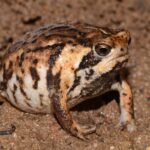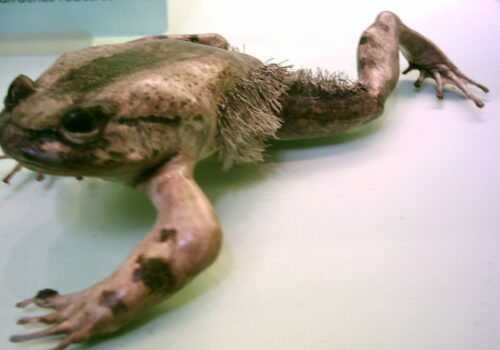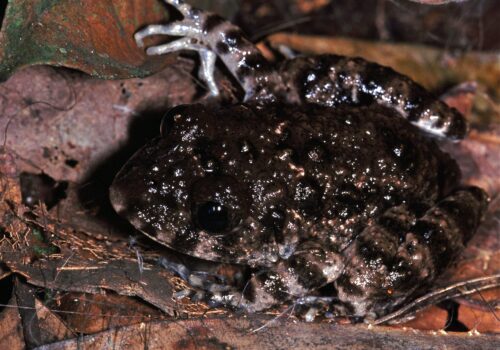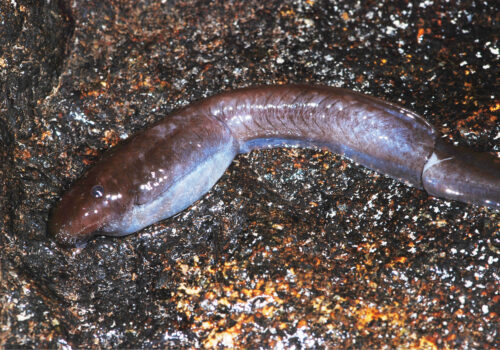Unveiling Nature’s Hidden Jewel: Exploring the Life of Leptopelis concolor, the Cameroon Forest Treefrog#
Amid the lush green tapestry of Central Africa’s rainforests, cloaked in mist and serenaded by a chorus of nocturnal creatures, lies a small, unassuming yet fascinating amphibian—Leptopelis concolor. Commonly known as the Cameroon forest treefrog, this elusive creature presents an intriguing dynamic within the ecosystem, captivating scientists, nature enthusiasts, and conservationists alike. With its modest size, cryptic colors, and melodious nocturnal calls echoing gently through the treetops, Leptopelis concolor embodies a unique testament to the beauty and diversity hidden deep within the heart of Africa’s forests.
The name Leptopelis concolor may not roll easily off the tongue, nor is it widely known outside specialist circles, yet understanding this remarkable frog offers a gateway into the vibrant tapestry of rainforest life and the delicate balance that sustains it. Whether it’s their opportunities for camouflage, nocturnal habits, or pivotal role in ecological relationships, exploring the life of the Cameroon forest treefrog reveals an intricate and vital part of biodiversity—and a compelling reason to preserve their fragile environment.
Taxonomy and Classification#
Belonging to the family Arthroleptidae, the genus Leptopelis encompasses a group commonly termed “tree frogs,” although they aren’t closely affiliated to the “typical” tree frogs of the family Hylidae. Instead, Leptopelis are Afro-tropical inhabitants, perfectly adapted to the unique conditions found in Africa’s rainforest ecosystems. As part of this distinct and fascinating genus, Leptopelis concolor shares its lineage with an array of closely related species, each bearing subtle yet enchanting distinguishing characteristics.
First described scientifically by the herpetologist George Albert Boulenger in 1898, the Cameroon forest treefrog remains an organism of relative scientific intrigue, its various nuances continuing to spark research endeavors. The specific epithet “concolor,” meaning uniformly colored or nearly featureless, elegantly hints at one of this species’ most treasured adaptations: its cryptic coloration.
Natural Habitat#
Within the verdant bounds of Cameroon, Equatorial Guinea, Gabon, Congo, Nigeria, and Central African Republic, Leptopelis concolor thrives in a highly specialized yet surprisingly adaptable niche. Primarily an inhabitant of lowland and montane tropical moist forests, these frogs occupy a vertical world spanning from lush leaf litter layers on the forest floor to the upper reaches of the tree canopy, deftly maneuvering through leafy branches and vines.
While often unseen, their presence is regularly betrayed by their distinct vocalizations, a symphony of soft croaks and trills emanating from the cover of dense foliage, particularly abundant after heavy rains. Frequently found near slow-moving forest streams or damp swampy depressions, they rely on moist microhabitats to maintain hydration and facilitate reproduction.
Here, rich organic matter carpets the ground, providing essential nourishment for a myriad of insects and arthropods—ready prey for hungry amphibians like the Cameroon forest treefrog. This complex web of life offers precisely what Leptopelis concolor demands: abundant prey, ample hiding spots, reliable breeding sites, and favorable thermal and humidity conditions.
Physical Characteristics#
While not striking in bright colors or elaborate patterns like the poison dart frogs lining neotropical realms, Leptopelis concolor captivates observers with its understated elegance. Measuring between 3 to 6 centimeters in length, these frogs exhibit a subtle yet magnificent beauty characterized by smooth, moist skin, a rounded snout, conspicuously large and expressive eyes adapted superbly for nocturnal activity, and powerful limbs indicative of its arboreal nature.
True to its scientific name, most individuals carry a uniformly muted coloration—generally soft hues of olive, brown, grey, or occasionally a gentle green—enabling near-perfect blending into foliage, bark, and leaf litter. This exceptional camouflage serves not only as an effective defense against predators but also affords these frogs precious stealth during nightly hunting sessions, quietly ambushing insects beneath moonlit canopies.
Their toe pads are well-developed discs, designed by millions of years of evolution to ensure a secure grip on slippery, rain-soaked leaves and branches, securing Leptopelis concolor’s position as an expert arboreal navigator. Illustrating nature’s ingenuity, these unique adaptations optimize survival in the dense, wet habitats in which they reside.
Behavior and Life Cycle#
Nocturnal Pursuits: A Life in Shadows#
Under cover of night, the Cameroon forest treefrog embarks upon its daily affairs, carefully avoiding daylight predators and the drying heat of the tropical sun. Equipped with acute nocturnal vision, enhanced by their considerable eye size and specialized retinas, Leptopelis concolor adeptly identifies and targets prey—which predominantly consists of a variety of insects, including moths, flies, spiders, and small beetles—with precise and explosive tongue movements.
The quiet, stealthy comportment of these frogs perfectly complements their subdued appearance, allowing them a secure and reliable lifestyle of cryptic predation. As omnipresent ambush predators in their vertical rainforest realms, each Leptopelis plays a part in maintaining Balance in arthropod populations, controlling s insect-consuming creatures that could otherwise explode to damaging ecological levels.
Calling for Love: Reproductive Rituals#
Particularly after rains have refreshed their habitat and fed the numerous surrounding pools and wetlands, male Cameroon forest treefrogs commence their distinctive calling rituals. From scattered perches—branches, broad leaves, or even elevated roots—they emit their uniquely melodious trills and repeated croaks, each male striving to attract attentive females and stake his claim to prime reproductive territory.
Their calls create a nighttime chorus, signaling to receptive females and subtly delineating territorial claims among competing males. Upon successful mating, typically hidden from the casual observer’s sight by dense primary vegetation, the female deposit clusters of gel-coated eggs into shallow water pools or damp, swampy areas among leaves and moss.
In these pooled sanctuaries, the aquatic tadpoles hatch, beginning their developmental journey to adult amphibians. Metamorphosis occurs over weeks to months, dependent on environmental conditions, and ensures continuation across generations, perpetuating the secretive yet essential presence of Leptopelis concolor within their rich forest habitats.
Ecological Role#
The presence of Leptopelis concolor exemplifies the intricate interconnectedness found in tropical ecosystems. These forest frogs play dual roles, simultaneously predator and prey. They contribute to essential ecological processes, regulating insect populations and facilitating nutrient cycling. Amphibians such as L. concolor represent a significant energy transfer step in rainforest food-webs, consumed themselves by larger predators—birds, snakes, and even small mammals—thus enriching biological diversity and stability within intricate ecosystems.
Moreover, amphibians like Leptopelis are frequently cited as ecological indicators, organisms whose health, abundance, and behavior reflect the overall environmental conditions of their habitats. Declines in their populations often signal deeper ecological issues such as habitat loss, forest deterioration, or contamination—thus highlighting their fundamental ecological significance for conservation monitoring.
Threats and Conservation Status#
While currently classified by the IUCN Red List as Least Concern—the fortunate beneficiary of widespread yet patchy distributions—the Cameroon forest treefrog still faces an uncertain future. Like elsewhere in the tropics, habitat degradation stemming from deforestation, agricultural expansion, logging industry practices, as well as pollution and changing climate patterns, pose significant threats to these sensitive amphibians.
Amphibians’ porous skins and biphasic life cycles leave them exceptionally vulnerable to environmental change and contaminants. Even those currently stable face pressure from human population encroachment and habitat fragmentation. Conservationists emphasize the importance of protecting intact forest tracts, advocating for sustainably managed landscapes and supporting local research and engagement.
Cultural and Scientific Significance#
While the Cameroon forest treefrog may lack the widespread cultural symbolism of charismatic megafauna, amphibians in general hold deep significance in many indigenous cultures as symbols of water, fertility, transition, and rebirth. Scientifically, Leptopelis concolor and relatives offer invaluable insights into ecosystem health, evolutionary biology, physiology, and biochemical adaptations that may have broader implications, including potential medicinal discoveries, ecological management techniques, and biodiversity assessments.
Conclusion: A Call for Conservation and Discovery#
Leptopelis concolor stands as a quiet yet powerful ambassador of Central Africa’s remarkable biodiversity. By shedding light on its hidden, fascinating world, we deepen our appreciation of Earth’s ecological treasures and gain clearer insight into our collective responsibility to protect the natural world. Let’s promote ecological stewardship, support continued amphibian conservation efforts, and encourage discovering the rich tapestry hidden in the silent shadows of our planet’s forests.










